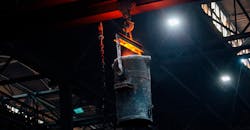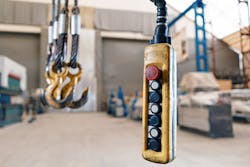Bringing Cranes into the Digital Age
Overhead cranes are used across countless manufacturing verticals and industries, including metalcasting, where applications range from scrap and material handling to hot ladle transfers, mold pouring, and diecasting. While there are various requirements of these operations, they all are rooted in the common requirement of rugged material-handling machines that can operate reliably in demanding environments. While the size and design of the cranes used in metalcasting may vary depending on the specific application, one truth holds steady: overhead cranes are there to ensure the highest levels of safety and productivity for your business.
To maintain optimal safety and productivity, it’s important to equip your cranes with the latest technologies, features and capabilities. In some cases, this might look like replacing your crane equipment. In other instances, modernizing your crane operations might look like intentional investments in specific pieces of equipment to work alongside your existing cranes.
Whichever approach makes the most sense for your business, bringing your cranes into the digital age will enable you to handle greater capacity, see faster operating speeds, reduce downtime and boost safety among operators. If you’re ready to explore options for optimizing your crane operations, here are three places to start.
1. Prioritize safety
Safety is critical in any industrial or manufacturing setting. According to a study from the U.S. Bureau of Labor Statistics, nearly 300 crane-related deaths occurred from 2011 to 2017. Just over half of the fatal injuries involved a worker being struck by an object in motion by a crane. By integrating modern safety features, plants and operators can bolster crane safety, reduce occupational injuries and optimize crane operations.
First, consider sensor-based systems. Advanced sensor technologies like load moment indicators, anti-collision systems and zone monitoring have become commonplace in modern cranes. These systems provide real-time data on load capacity, stability, and potential hazards, ensuring safer operations.
Next, leverage all the data from the sensors to form a predictive maintenance plan. By leveraging operational data, crane operators can detect maintenance issues before they escalate into safety hazards. Predictive maintenance enables proactive maintenance scheduling, reducing the risk of breakdowns, accidents and downtime.
2. Invest in the right radio remote
Radio remote-control systems have revolutionized crane operations by offering operators increased flexibility, convenience, and safety. They are commonly used in place of pendant push-button stations or fixed control stations and cabs. They’re also a quick and easy place to start if you want to modernize an outdated crane.
Moreover, radio remote devices contribute significantly to the digital transformation of crane operations by boosting precision control, increasing ergonomics and usability and integrating with additional safety features.
Radio remotes provide operators with greater freedom of movement, enabling them to control cranes from a safe distance. This improves visibility and accuracy, reducing the risk of collisions or accidents during complex lifting operations. Some modern solutions also have tandem crane control, which makes it possible to control two cranes from one device.
From an ergonomics perspective, invest in a radio remote that balances functionality with durability. New solutions in the market have a lighter weight and more compact design than the former standards, and they fit more comfortably in an operator’s hand for prolonged use.
Lastly, look for a radio remote that can be replaced easily. Manufacturing environments are demanding, and any downtime is money lost. New solutions in the industry make the replacement and deployment processes of radio remote controls seamless. They no longer require crane operators to drop power to cranes to put them into a pairing mode, or to place a worker into a manlift to complete the pairing. This simple change contributes to heightened safety and efficiency.
3. Consistent communication, data transfer
The third point to consider for bringing cranes into the digital age is to prioritize technologies that support data transfer. Energy and data transmission systems play a crucial role in safe, reliable, and efficient operation of overhead cranes. Because cranes have many different designs and functions, the power and control systems are created to meet specific requirements.Power and control systems must handle different sizes and weights of goods and move them in specific directions at specific speeds. For facility managers and operators, this means creating the most secure, direct and clear line of communication is critical, especially for those looking to modernize operations with automation.
Traditionally, automation and digital transformation have been strongly associated with Wi-Fi infrastructure, but Wi-Fi can have drawbacks in crane operations, like the potential for outages, cybersecurity risks, inconsistent coverage and limited range. This unplanned downtime comes with a cost. One study showed the average manufacturer runs into 800 hours of equipment downtime per year – more than 15 hours per week. Another report estimated this problem costs industrial manufacturers $50 billion annually.
To avoid costly disruptions and truly bring your crane into the digital age, consider infrastructure beyond Wi-Fi – for example, a hardwired Power Line-Fidelity (PLi-Fi) connection. A solution like this can be retrofitted easily an already operating crane, has nearly no maintenance requirements, and works across conductor types and existing footprints. The result is enhanced security, reliability, and visibility for plant teams.
Simple upgrades with lasting impact
Overhead cranes are a significant investment for your metalcasting business, running upwards of tens of thousands of dollars to purchase or replace. Bringing a crane into the digital age with simple, more cost-effective upgrades extends its service life and can keep it running efficiently and safely for years to come. The impacts of these upgrades will be far-reaching, from decreased downtime to increased safety.
Brian Cook is a senior product manager at Conductix-Wampfler, a developer and supplier of intelligent energy supply and data management systems for moving machinery.

